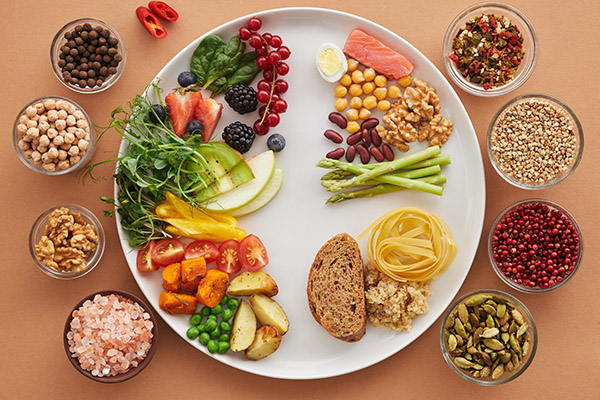How Nutrition Helps You Reach Your Wellness Goals
By Kristy Warren
Nutrition is the bedrock of good health. What we eat fuels us and can impact our physical, mental, and emotional well-being. Gena Rasmussen, MS, RD / LDN, a registered dietitian with the Laurel Health Centers, shares how nutrition impacts our wellness, simple tips for incorporating healthy options into our diet, and how to make sustainable changes for developing healthy habits that last.
EATING HEALTHIER AND STICKING TO IT
It’s easy to get overwhelmed by all the information available around nutrition. From misinformation and dangerous crash diets to the lack of personalized recommendations and professional medical sources, it can be difficult to sift through the information overload to find the right steps you should take to eat well and meet your wellness goals.

“There’s an overabundance of nutrition advice and misinformation these days; patients can quickly become overwhelmed and end up taking no action at all,” Gena explains. “My goal is to work with my patients on a personal level and develop a customized plan that leads to healthy, sustainable habits—one good habit at a time. My favorite thing about what I do is helping people believe in themselves and their ability to improve their own health.”
Gena has more than 25 years of experience in nutrition care. She earned her Bachelor of Science degree in Dietetics and Food Service Management from Mansfield University and her Master of Science degree in Nutrition from University of North Carolina Greensboro.
Not sure where to start? Gena shares helpful tips in the short video below, including the role nutrition plays in our health, how better eating habits can help us reach our wellness goals, and steps you can take today to build delicious, well-balanced meals:
THE BENEFITS OF EATING SEASONALLY
As the seasons change, so do the fruits and vegetables being grown. Eating seasonally refers to eating fresh produce that is currently “in season” in the region where you live. Prior to the globalization of food sourcing, people harvested and ate food on a much more seasonal schedule. While many foods are now available year-round, there are benefits to focusing on what is in season, including environmental, financial, and health benefits.
Local produce doesn’t have to travel as far, meaning it will usually be both cheaper and fresher than goods that have to travel from far away. It also decreases the carbon footprint of the food by cutting down on long-distance shipping. In-season produce also has better, richer flavor and higher nutrient levels, especially when harvested at its peak with short transit times to supermarket shelves—compare the taste of summer’s in-season local strawberries to out-of-season strawberries you’ve picked up during the winter months.

Changing with the seasons also means varying the types of produce in your diet (e.g., citrus fruits in the winter, rhubarb in the spring, berries in the summer, and apples in the fall).
Eating a wide range of vegetables and fruits throughout the year helps assure you’re getting the variety of nutrients you need without getting stuck in a rut or becoming bored of the same produce.
SIMPLE WAYS TO ADD MORE PRODUCE INTO OUR DIET
Sometimes it’s a challenge to get enough fruits and vegetables into our meals, especially if there’s a picky eater in the family. If your children are reluctant to eat fruits and veggies, involving them in preparing the meal can help them feel included and invested in the final product, making them more likely to try something new.
Here are a few simple ways to boost your servings of produce at each meal:
Start your day right with a nutrient-packed breakfast! Whether you prefer sweet or savory breakfast foods, there are easy ways to add extra health to common breakfast staples.
Breakfast: Try adding nuts, seeds, or fresh fruit like berries or banana to your breakfast cereal, yogurt, granola, or oatmeal. If you prefer savory foods for breakfast, try avocado toast or jazz up scrambled eggs and omelets by adding in peppers, spinach, onion, scallions, mushrooms, or tomatoes.


Lunch: From veggie wraps to side salads and soup, there are a lot of great options for upping your veggie count at lunch.
If adding fruits or veggies to your existing meals is proving to be a challenge, give smoothies a chance. Blended fruit or vegetable smoothies are a great way to add more plant-based nutrition to your meal lineup.
Dinner: Fruits and vegetables can take center stage as the main dish or complement the meal as side dishes and dessert. You can even add them into some recipes that don’t originally call for them. Grated carrots and zucchini are easy to slip into many recipes to add a little extra nutrition without impacting the dish’s taste.
Soups are another great opportunity to add in veggies like corn, celery, green beans, tomatoes, onions, and carrots. Pureed baked squash and sweet potato can also make soups / bisques richer and more flavorful.

Snacks: Grab a piece of fruit, sunflower seeds, or a handful of baby carrots for a quick, healthy snack. Tired of the same old options in the fruit bowl? Shake it up with fruit you don’t try often like kiwi, mango, pineapple, kumquat, plantains, or jackfruit.
HOW PROPER NUTRITION CAN HELP US ACHIEVE OUR WELLNESS GOALS
Diet and exercise can help patients improve their fitness, mood, and energy. Most people can benefit from getting back to the basics: add more movement and nutrition to your daily routine. A good place to start is by building a healthy plate with these straightforward steps:
- Aim for a balanced diet of fruits, vegetables, whole grains, lean protein, and healthy fats. Healthy meal planning guides can help you find well-balanced meals the whole family will enjoy.
- Stay hydrated. Not only is getting enough water essential for your body to properly function, but it can also be an important tool in helping people lose weight or maintain a healthy weight by supporting your metabolism and curbing the urge to overeat.
- Understand portion sizes. Recommended portion sizes vary by the type of food, and some foods pack a lot more nutrients per serving than others. Learning what constitutes a serving size, how many servings you should aim for in each food group, what foods are nutrient-dense, and which nutrients your food provides are all part of building a healthy plate. For examples of healthy plate options, including helpful information on food groups and portion sizes, visit myplate.gov/myplate-plan.
- Incorporate more plant-based nutrition from fruits, nuts, seeds, whole grains, and vegetables. These nutrient-dense foods help ensure you get your essential vitamins.
- Minimize your intake of heavily processed foods and items high in fat / sugar. These foods are often high in calorie count but low in nutritional value (sometimes referred to as “empty calories”), so it’s important to eat them in moderation and focus on consuming healthy foods more often.
- Talk with your healthcare provider about your health goals to get customized expert advice on how to make the right changes to your diet—while some tips are appropriate for everyone (like “eat your fruits and veggies”), if you have specific conditions or goals, you may need a personalized approach to achieve the results you want.
WHERE TO TURN FOR EXPERT GUIDANCE & PERSONALIZED PLANS
It’s always best to discuss lifestyle changes like diet and exercise with your healthcare provider before starting new diet and exercise routines. Changes to your diet should be health-focused, realistic, and sustainable so you can stick to the changes while safely meeting your wellness goals. If you’re looking to improve your health, manage a chronic condition, or lose weight, talk to your healthcare provider for personalized advice and support that’s specific to your needs.
Your physician may recommend meeting with a dietitian. Dietitians are medical professionals who specialize in nutrition and its role in improving and managing your health. Depending on your insurance plan, you may need a referral to schedule an appointment with a dietitian; your insurance provider will be able to guide you on whether or not a referral is needed.
If you need personalized nutrition recommendations and support, Laurel Health is here to help. To learn more about how nutrition impacts your health or how to get referred to our dietitian, call 1-833-LAURELHC (1-833-528-7354) or click here for a full list of our locations.
